ASUS M2N32-SLI & Epox MF570SLI: AM2 Wunderkinder
by Wesley Fink on June 28, 2006 5:10 AM EST- Posted in
- Motherboards
General Performance
With the Memory Controller on the Athlon 64 Processor, Winstone benchmarks are no longer very revealing of motherboard performance. With the same CPU (and the same memory controller on that CPU) both Winstones are tightly clustered. The only deviation from that is that boards that are tweaked for best gaming performance are often near the bottom of a tight range of benchmark performance numbers. The Winstone tests themselves are rapidly becoming dated, and are no longer supported by PC Magazine/VeriTest. While Winstones are still useful in providing real world performance data in CPU testing, we have dropped Winstones from our standard motherboard test suite.
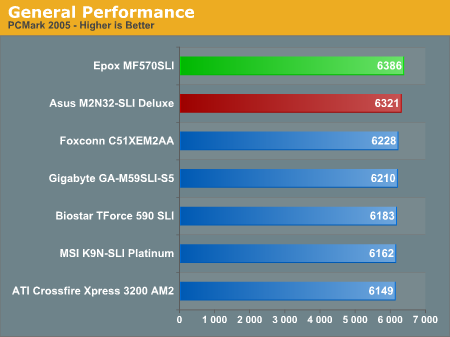
PCMark 2005 results for the seven AM2 boards show the Epox 570 at the top of the performance chart, followed closely by the ASUS M2N32-SLI. These results are very much in line with other results. Despite the close results in these tests, PCMark05 is proving to be a useful overall performance benchmark. It is generally more sensitive than the older Winstones and PCMark04 to recent improvements in PC architecture. PCMark05 results in general relate well to the other performance results we find in our board tests - providing a quick and reliable snapshot of board performance compared to other motherboards.
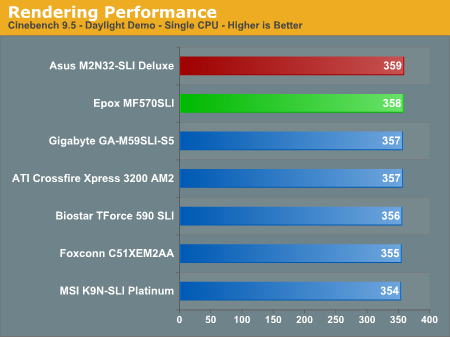
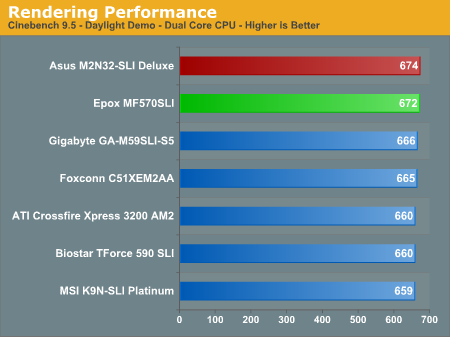
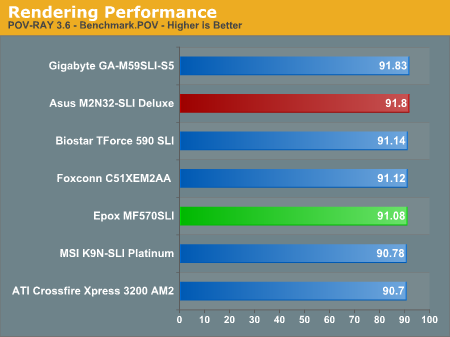
We have replaced Winstones with two benchmarks that use rendering to test system performance. Cinebench 9.5 and POV-RAY 3.6 benchmarks both heavily stress the CPU subsystem while performing graphics modeling and rendering. We utilize the standard benchmark demos in each program along with the default settings. Cinebench 9.5 features two different benchmarks with one test utilizing a single core and the second test showcasing the power of multiple cores in rendering the benchmark image.
While results are generally close in Cinebench, the ASUS 590 tops both Single-Core and Dual-Core test results, followed closely by the Epox in both tests. POV-Ray results are extremely close across DDR2 platforms and show the Gigabyte to be the top performer, followed closely by the ASUS. The Epox performance on POV-Ray 3.6 falls in the middle of the pack.
3D Graphics
The 3DMark benchmarks, published by Futuremark, are probably the most widely quoted gaming performance benchmarks available. While the benchmarks are based on game sequences written by Futuremark to reveal subtle differences in gaming performance, they still have to be considered synthetic benchmarks. They are useful for broad graphics comparisons, but they are no substitute for benchmarks with real gaming engines that are currently being played.
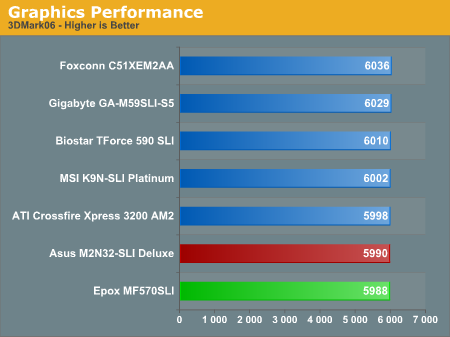

After topping PCMark2005 it was a surprise to see both ASUS and Epox nailing down the bottom of 3DMark performance. Results were close, differences were minor, but neither the ASUS nor Epox stood out from the pack in these benchmarks. 3DMark06 is the newest 3DMark and you can find more in-depth information about this version in the AnandTech article Futuremark's Latest Attempt: 3DMark06 Tested.
Encoding
We have found encoding results are not affected by the graphics card used during the encoding benchmarks, which should come as no surprise since theoretically this is to be expected. This is demonstrated again and again by archive test results for AutoGK using an AMD 4000+ processor with a wide assortment of video cards. The performance range of encoding tests over 2 years with the same CPU is just 48.1 to 49.1 - a difference form high to low of just 1.0 frame per second. Clearly the biggest influence on this encoding benchmark is the CPU used for testing. Because encoding test results vary so little on the same standardized motherboard test platform, they have been dropped from this review and future reviews. Encoding tests are very useful in CPU testing, but they have been shown to be poor motherboard tests - particularly on the AMD platforms with the memory controller on the CPU.
With the Memory Controller on the Athlon 64 Processor, Winstone benchmarks are no longer very revealing of motherboard performance. With the same CPU (and the same memory controller on that CPU) both Winstones are tightly clustered. The only deviation from that is that boards that are tweaked for best gaming performance are often near the bottom of a tight range of benchmark performance numbers. The Winstone tests themselves are rapidly becoming dated, and are no longer supported by PC Magazine/VeriTest. While Winstones are still useful in providing real world performance data in CPU testing, we have dropped Winstones from our standard motherboard test suite.

PCMark 2005 results for the seven AM2 boards show the Epox 570 at the top of the performance chart, followed closely by the ASUS M2N32-SLI. These results are very much in line with other results. Despite the close results in these tests, PCMark05 is proving to be a useful overall performance benchmark. It is generally more sensitive than the older Winstones and PCMark04 to recent improvements in PC architecture. PCMark05 results in general relate well to the other performance results we find in our board tests - providing a quick and reliable snapshot of board performance compared to other motherboards.



We have replaced Winstones with two benchmarks that use rendering to test system performance. Cinebench 9.5 and POV-RAY 3.6 benchmarks both heavily stress the CPU subsystem while performing graphics modeling and rendering. We utilize the standard benchmark demos in each program along with the default settings. Cinebench 9.5 features two different benchmarks with one test utilizing a single core and the second test showcasing the power of multiple cores in rendering the benchmark image.
While results are generally close in Cinebench, the ASUS 590 tops both Single-Core and Dual-Core test results, followed closely by the Epox in both tests. POV-Ray results are extremely close across DDR2 platforms and show the Gigabyte to be the top performer, followed closely by the ASUS. The Epox performance on POV-Ray 3.6 falls in the middle of the pack.
3D Graphics
The 3DMark benchmarks, published by Futuremark, are probably the most widely quoted gaming performance benchmarks available. While the benchmarks are based on game sequences written by Futuremark to reveal subtle differences in gaming performance, they still have to be considered synthetic benchmarks. They are useful for broad graphics comparisons, but they are no substitute for benchmarks with real gaming engines that are currently being played.


After topping PCMark2005 it was a surprise to see both ASUS and Epox nailing down the bottom of 3DMark performance. Results were close, differences were minor, but neither the ASUS nor Epox stood out from the pack in these benchmarks. 3DMark06 is the newest 3DMark and you can find more in-depth information about this version in the AnandTech article Futuremark's Latest Attempt: 3DMark06 Tested.
Encoding
We have found encoding results are not affected by the graphics card used during the encoding benchmarks, which should come as no surprise since theoretically this is to be expected. This is demonstrated again and again by archive test results for AutoGK using an AMD 4000+ processor with a wide assortment of video cards. The performance range of encoding tests over 2 years with the same CPU is just 48.1 to 49.1 - a difference form high to low of just 1.0 frame per second. Clearly the biggest influence on this encoding benchmark is the CPU used for testing. Because encoding test results vary so little on the same standardized motherboard test platform, they have been dropped from this review and future reviews. Encoding tests are very useful in CPU testing, but they have been shown to be poor motherboard tests - particularly on the AMD platforms with the memory controller on the CPU.










23 Comments
View All Comments
Missing Ghost - Wednesday, June 28, 2006 - link
yep the choice of I/O ports on the back panel is pretty poorLarso - Wednesday, June 28, 2006 - link
Perhaps someone should clarify this for me. I have been noticing how there is a growing interest in how the motherboard makers have done the power conversion for the CPU. Why has this become an issue to investigate?I don't think there was a similar focus on the power converters for the netburst chips, which I believe soaked a lot more juice than these AMD chips. I believe they managed to deliver stable power to the netbursts without needing an 8 phase converter cooled by heatpipes??
I'm fearing that the motherboard producers will start to create extravagant and foolishly designed converters to please the reviewers. I believe there is no good reason to go for an 8 phase design, when a 4 phase would do the job, considering the money that can be spend on each phase. And that ASUS need to cool the converter by heatpipe seems to indicate that the convertion have a bad effeciency, is this really a step forward?
I really enjoy reading more about the technical solutions on the motherboards, but it just seems to me that the power converter should be less of an issue now, than with the power hungry netburts?
Operandi - Friday, June 30, 2006 - link
A 8 phase design is more efficient then a 4 phase, not less.Missing Ghost - Wednesday, June 28, 2006 - link
It seems to me that the heatpipes are more for cooling the chipset in fact.erwos - Wednesday, June 28, 2006 - link
What WiFi chipset does it use? "It has WiFi" is not terribly precise.-Erwos
Wesley Fink - Wednesday, June 28, 2006 - link
The WiFi chip used on the Asus WiFi module is Realtek RTL8187L. The Features have been updated to reflect this.Wesley Fink - Wednesday, June 28, 2006 - link
Asus refers to the Wi-Fi in specifications as "WiFi Home USB wireless module supporting IEE 802.11 b/g". There is no mention at all of the supporting chip. The module is attached to the motherboard and the chip is loacated behind heatpipes. We can't read the model number, but the logo is clearly Realtek.highlnder69 - Wednesday, June 28, 2006 - link
On page 8 under Half Life 2 - SLI Gaming Performance, I think that the Asus Single/SLI results are labeled incorrectly. It's currently showing the Single card configuration with the highest FPS results and the SLI with the lowest.Wesley Fink - Wednesday, June 28, 2006 - link
You are correct, the labels were reversed. They are now corrected.DigitalFreak - Wednesday, June 28, 2006 - link
Someone needs to teach the idiots at Asus about how to design the proper motherboard layout. With an SLI setup with dual width cards, there's no PCI-E slots available.